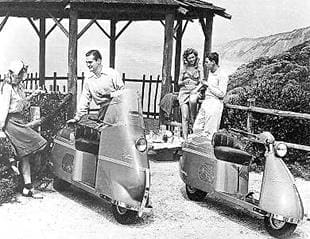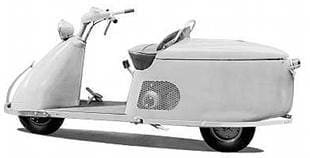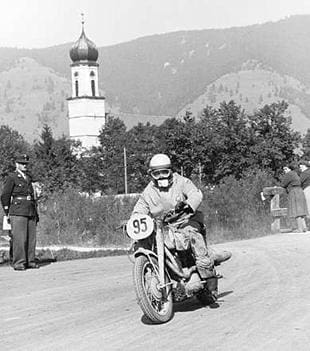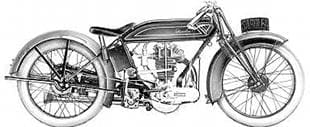Sadrian 1956-63 Spain
Established maker of lightweight three-wheelers who branched out into lightweight motorcycle manufacture, using 125-200cc Hispano-Villiers power.
Salsbury 1935-49 USA
Super salesman and entrepreneur E Foster Salsbury conceived his idea for cheap personal transport in 1935. Salsbury folklore claims EFS had one of those flashes of inspiration as he spotted female aviator Amelia Earhart zipping round the Lockhead Airport Burbank, California on a veteran Motoped scooter.
In later interviews Salsbury stated he hired inventor Austin Elmore to design his first basic economy scooter, the Motor Glide. Using a lightweight tubular frame with pressed steel footboards the scooter employed an 82.5cc Evinrude two-stroke stationary engine driving the rear wheel directly by a crankshaft mounted friction roller.
Folklore claims E Foster Salsbury set off for a family holiday at Palm Springs in February 1936 with his prototype scooter packed in the car boot. He called in at the Airplane and Boating Show in Los Angeles and demonstrated his scooter to renowned American aviator Roscoe Turner.
Turner was – like Salsbury – a flamboyant character. Wearing an immaculate colonel’s uniform (he held an honorary commission in the state National Guard), Turner was his own best publicity agent. However, it wasn’t all showmanship as Turner won the 1933 Bendix Trophy and the Thompson Trophy air races three times.
Turner fell for the Motor Glide claiming it – with a now highly non-PC statement – “The best woman catcher I’ve ever seen,” and immediately placed the 65lb scooter in his promotional booth at the air show. With a further piece of promotional ‘luck’ child star Freddie Bartholomew (Little Lord Fauntleroy) publicly ordered one.
Timing is often everything but in hindsight we may either wonder at or admire Salsbury’s bravery the world had ever seen, America was climbing out of the worst depression, with millions unemployed. Salsbury envisaged the need for cheap basic transport to help get America moving again. His foresight was spot on, but the road to riches is paved with blips and the Motor Glide suffered the odd hiccup.
While the engine and basic chassis with its tiny pneumatic industrial wheels worked well, on a rainy day the roller drive didn’t. In wet conditions, the roller spun on the tyre, creating impressive water plumes but little go.
By late 1936 a new Motor Glide Scooter was promised, with chain drive, while E Foster Salsbury had created the Salsbury Corporation, with a full production line at new premises in Los Angeles. Next came more luck – or was it crafty publicity driven planning? With Hollywood nearby, actress Olivia de Havilland cruised the studio lots on a Salsbury, for the press at least! Bing Crosby took another on holiday to Honolulu – funny, the press were on hand again! – singer Scat Davis… and so it went on. But so too did the Salsbury. By subcontracting when overstretched the Salsbury Corporation kept pace with strong demand.
New versions appeared including the De Luxe High Speed (35mph) and customers could personalise their scooters with a choice of colours and an ever growing range of accessories. In 1937 came the 100cc four-stroke Johnson-engined Aero Motor Glide, which although slower than an Evinrude could squeeze over 150mpg. Soon, further fitments were available, including a parcel carrier.
To increase the passe nger or commercial payload came two sidecar options. The Model SC-11 passenger sidecar looked like a cross between a tin bath and a Roman chariot and the SC1 was in effect a commercial tub mounted on a third wheel, for both the makers stated suspension was by means of the sidecar’s 12in pneumatic tyre and body flex – comfortable eh?
nger or commercial payload came two sidecar options. The Model SC-11 passenger sidecar looked like a cross between a tin bath and a Roman chariot and the SC1 was in effect a commercial tub mounted on a third wheel, for both the makers stated suspension was by means of the sidecar’s 12in pneumatic tyre and body flex – comfortable eh?
Then there was the Model 64 Cycletow, which became the Model CT-60. It was an attachment with wheels mounted to the scooter’s rear that could be lowered or raised for towing the scooter behind a car or van, a variation of the theme employed by Harley-Davidson and Indian for their commercial three-wheelers.
Sales boomed but Foster Salsbury wasn’t a man to rest on his laurels. For 1937-8 came the 5⁄8hp Model 50 and 1 or 11⁄2hp Model 60 with Salsbury’s new ‘Self Shifting Transmission’, a combination of automatic clutch and a torque converter relying on V-belts and pulleys. Today we know such machines as twist-and-go scooters but in 1937-38 it was truly innovative work.
For 1939 E Foster Salsbury proudly unveiled his next models, the Standard Seat Model 70 and the de-Luxe Floating Seat Ride Model 72, both with restyled bodywork and powered by a 150cc four-stroke Lauson engine. The model bristled with updates including to the suspension, easy lift hood (bodywork) for servicing access and see-through panels to give a glimpse of the engine. The Model 72 came with automatic transmission, an optional extra for the Model 70.
Again sales were strong and The Salsbury Corporation was a winner during the early days of WWII. Often during war, fuel is rationed, so cheap frugal transport is required – Salsbury owners could squeeze 100-150mpg (Imperial gallon) taking owners farther than most. As America came into the war, Salsbury switched to military work including the Turret Truck, a novel forklift with revolving front section, plus aircraft aerodynamics development. By late 1943, Salsbury scooter supply had dwindled, although 200 were built for the US Navy and further models with stretcher sidecars for the Red Cross.
As WWII played out its final acts, E Foster Salsbury sold the Salsbury Corporation to AVION Inc of Los Angeles. The military defence contracting firm changed its name to Salsbury Motor Inc, in part to resume scooter manufacture and in part to cash in on the reputation the Salsbury Scooters had earned.
With a new plant, the restructured company came up with the Model 85, offered in Standard or De Luxe trim with an extensive range of accessories. Depending on your viewpoint the Model 85 was futuristic, outrageous, radical, handsome, ugly… Powered by Salsbury’s own 6hp four-stroke engine and designed by Lewis Thostenson, and of the twist-and-go variety.
Revolutionary the Model 85 may have been, with its aerodynamic bodywork and impressive marketing campaign, but in Salsbury terms it flopped. Estimates suggest under 1000 were built over two years and that was then the end of scooter production. Perhaps as Mr E Foster Salsbury later observed the timing was wrong –  scooter demand was falling as cars became more readily available. Many claim the designs of Austin Elmore and E Foster Salsbury had a massive influence on modern scooter design. There is no doubting many European post-WWII scooter makers – including Piaggio – had taken a long look at Salsbury scooters in 1938, as a sales team from the Salsbury Corporation endeavoured to interest European firms in making Salsburys under licence. Though the sales team went home with an empty order book, many new eyes had closely examined Salsbury’s blueprints…
scooter demand was falling as cars became more readily available. Many claim the designs of Austin Elmore and E Foster Salsbury had a massive influence on modern scooter design. There is no doubting many European post-WWII scooter makers – including Piaggio – had taken a long look at Salsbury scooters in 1938, as a sales team from the Salsbury Corporation endeavoured to interest European firms in making Salsburys under licence. Though the sales team went home with an empty order book, many new eyes had closely examined Salsbury’s blueprints…
These same observers note that all subsequent scooters featured at least three or more of Salsbury’s main design features of small wheels, engine beside rear wheel, step though bodywork, automatic transmission and engine enclosing bodywork. However, some scooters by other makers of the immediate pre- and post-WWI era featured three or four of these features too, so where does that leave us?
Salsbury scooters are part of the American dream, odd examples survive in Europe but are seldom offered for sale. In truth, we don’t understand their appeal and wouldn’t spend Velocette Venom or Vincent Comet money on a tiny stationary-engined scooter, but then the Salsbury isn’t part of our culture.
Sanglas 1952-82 Spain
Barcelona firm, which began manufacture with ohv 248, 347 and 423cc unit construction four-speed singles in 1951, but may have been involved in pre-production development before. In the mid-1950s a smart, upright 500 was launched which was to serve the Spanish police force well for decades. Reports suggest far more were sold to the police than on the civilian market.
Towards the late-1950s, Sanglas began supplying their 350cc and 500cc singles in military trim to the Spanish forces and to a number of South American countries. These were again unit-construction ohv vertical singles developing 21 and 25bhp respectively. In the early 1960s, to further increase their market share Sanglas introduced a range of mopeds and light-to-medium weights with Zundapp or Hispano-Villiers two-stroke power and marketed under the Rovena brand.
 Once of advanced design, Sanglas continued with more of the same through the 1960s but for the most part shunned development. In the 1970s they tried to update their singles – cosmetically at least – but the faithful single-cylinder engines continued. Disc brakes somehow looked out of place on a traditional Sanglas and unfortunately the world wasn’t yet ready for retro models, so sales diminished. Supply continued to the police and the Spanish and South American military still placed contracts for the 417cc model – which replaced the 350 for service work – and 497cc singles.
Once of advanced design, Sanglas continued with more of the same through the 1960s but for the most part shunned development. In the 1970s they tried to update their singles – cosmetically at least – but the faithful single-cylinder engines continued. Disc brakes somehow looked out of place on a traditional Sanglas and unfortunately the world wasn’t yet ready for retro models, so sales diminished. Supply continued to the police and the Spanish and South American military still placed contracts for the 417cc model – which replaced the 350 for service work – and 497cc singles.
By the late 1970s, Sanglas had developed a massive 747cc dohc four-valve single with belt-driven cams but this concept was stillborn as they were becoming involved with Yamaha, who Sanglas hoped would be their saviour. During their last few years, models in production included the traditional 500S single and a new Yamaha-powered 392cc twin.
Unfortunately their modern styling attempts – along with support from Yamaha – failed to save Sanglas, who ended production in 1982. Rather a shame as they were good solid machines, which in the early 1950s were of advanced design and a 100mph 500 single can’t be such a bad thing, even today.
San Sou Pap 1923-36 France
Maker from Colombes, who derived their brand name from ‘sans soupapes’ (without valves). A smart choice of name, as production began with 100-250cc Train two-stroke engined velomotors and lightweights. Then, they lost the branding plot to build some cracking models with JAP and MAG four-stroke engines.
Sanatmaria 1951-63 Italy
Range of worthy but not startling mopeds and up to 147cc lightweights with Ilo, Sachs and Zundapp power.
San Yang 1962- Taiwan
Began production assembling chassis parts for Honda from Japanese-made components. Then moved onto manufacturing small components and gradually improved their engineering abilities. San Yang then undertook assembly of complete machines using their own chassis but Honda built engines to sell under the San Yang brand. In effect these were older-style Honda motorcycles, scooterettes and mopeds built initially for an Asian market hungry for cheap, small-capacity machines.
Although two-stroke lightweights and scooters were added to their range, the Honda-like 72cc ohc San Yang 80KC8E scooterette has remained a top-selling favourite.
Saracen 1967-73 UK
A true trials enthusiast, Robin Goodfellow designed, built, rode and sold in kit form his Sachs-engined Saracen mini trials motorcycles. Working in a small Cirencester workshop, Goodfellow brazed up the chassis using preformed tubing from Technical Tubes Ltd. Within a couple of years the Saracen, still in kit form, was selling well through a number of dealers and running a works team.
Team winners in the 1971 Scottish Six Days Trial and contenders in many nationals, Saracen were outwardly successful, but behind the scenes they struggled financially. The following year David Brand bought Saracen lock stock and barrel, moving the entire operation to larger premises at Watford, Hertfordshire. With a bigger output Brand hoped to cut costs to push the operation into profit. Models offered were in 123, 169 and 188cc (overbored 169cc) capacities, all with Sachs power.
Plans were afoot to up engine options to 250cc but Saracen had lost momentum and the days of the mini trials bike as a serious contender were over. The last Saracens were built in 1973. Today they make an interesting trials diversion and were extremely well made. With good spares back-up from Germany for the Sachs engines.
Sarolea 1896/8-1963 Belgium
Liege-based armaments factory established c1850 by Mainson Sarolen, who later began making bicycles and then towards the close of the 19th century began experimenting with motorcycles. Like many cycle makers they began motorising sturdy cycles then progressed to a range of single-cylinder and V-twin motorcycles. Back in production after WWI, Sarolea began a huge promotional campaign of their machines through advertising and competition, especially racing, both nationally and through much of Western Europe. Throughout much of the mid-1920s Sarolea’s race programme centred around a long stroke (80.5 x 97mm) 494cc single, which was durable, fast and – like the pushrod Norton of the same period – revved incredibly well.
Major race wins began in 1923 with the Liege-Nice-Liege endurance event and the Belgian GP. Saroleas went on to score many national victories and also secured much success in Italy. Retiring from racing in 1926, the Sarolea continued to be seen at national events.
Building 20,000 motorcycles per year through the late 1920s Sarolea – like many big companies – was badly hit by the depression leading them to introduce a utility two-stroke lightweight range in the early 1930s. They continued to make sporting up-to-500cc ohv single-cylinder roadsters too.
As Europe prepared for WWII Sarolea – like FN – began developing machines from civilian models for the Belgian forces including 350cc and 600cc side-valve singles. Later, the Belgian military placed orders for 300-plus side-valve flat twins with three forward and two reverse gears developed for heavy duty sidecar work. These along with other Belgian military machines were commandeered by the German military.
After WWII Sarolea restarted civilian production with their tried and tested range of up to 600cc ohv singles. Then in 1950 Sarolea began introducing new models from 125cc single-cylinder two-strokes to a 500cc ohv parallel twin. By the mid-1950s Sarolea were struggling for sales as cars became more affordable and popular.
They entered business arrangements with rivals FN and Gillet-Herstal in an attempt to halt the slide. In 1956 Sarolea tried worthy mopeds with 49cc two-stroke Ilo engines and assembled Italian Rumi Formichino scooters under the Djinn brand, which they launched at the 1956 Salon de Bruxelles.
By 1960 Sarolea were financially sunk. Merging with Gillet-Herstal put off the inevitable until 1963 when the last few Sarolea machines were built.
Saund 1962-85 India
Small, 98cc single-cylinder two-stroke commuter motorcycle with design based on DKW. There are a handful of survivors.
Scarab 1967-85 Italy
An alternative brand name for Ancilotti off-road lightweights which used Hiro, Sachs and Franco Morini two-stroke engines.
Scarabeo 1968-(80) Italy
Brand used by Aprilla for a range of Hiro and Sachs up to 125cc two-stroke off-road models. Again of low value. (Aprilla have more recently used the Scarabeo as a model name for selected scooters).
Schickel 1912-15 USA
Large 650cc single-cylinder two-stroke, mounted in a cast alloy chassis. Possibly not the first example of this concept, but certainly an early and interesting attempt. Odd survivors are claimed to exist and even surface at auction.
Schliha 1924-33 Germany
Production began in Berlin of what can only be described as a bizarre lightweight two-stroke with a form of ohv gear. Later added up-to-600cc models to the range. Mentioned here as early examples represent an interesting, although perhaps not that successful, concept. No evidence of survivors.
Schnell-Horex 1952-54 Germany
Famous racer and racing development engineer Roland Schnell built a modest number of 250/350/500cc racing motorcycles using single-cylinder ohc Horex engines, developed by the Horex factory. Odd examples survive and HP (Happy) Muller, who won the 1955 250cc world crown on a semi-works NSU Sportmax, is listed among the front runners who raced Schnell-Horex machines at German national events in the early-to-mid 1950s.
Schurhoff 1949-53 Germany
Gevelsburg cycle maker that built an extensive range of mofas and mopeds using proprietary engines, as well as Ilo two-stroke engined 123 and 175cc motorcycles.
Schuttoff 1924-33 Germany
An established engineering works and machine factory, Schuttoff began with worthy, small 246cc side-valve commuters. As modest sales picked up, 346cc side-valve and ohv models were added to the range and then 496cc singles, again in both side-valve and ohv forms. They ran a semi-works and then full works racing team which enjoyed much success, especially at national level during 1925-29. A number of riders campaigned Schuttoff singles in trials, most notably Josef Mittenzwei with his ohv 500 single sidecar outfit.
In 1930 Schuttoff began links with the noted world-leading two-stroke factory DKW, whose engines they began fitting in their lightweight up to 300cc models. In 1932, DKW took over Schuttoff and their works ending production in 1933 in favour of DKW machines.
Schweppe 1949-50 (54) Germany
Range of unconventional scooters with their headlights housed within the front mudguard, built by Pirol-Fahrzeugfabrik GmbH (formally Firma Schweppe) of Dortmund. A large crucifix mounted on the front leg-shield carried the marque logo.
Originally marketed as the Schweppe, then, when Pirol-Fahrzeugfabrik GmbH was established, as the Miranda, before becoming the Pirol.
All two-strokes, the best known models were the Ilo-engined Pirol 145, Kuchen-powered Pirol 200 and Miranda 200 with a Sachs unit. Considered by scooter stylists as an ugly duckling, they are becoming sought after by collectors and at least spares are still available for Ilo and Sachs engines.
Scootavia 1949-54 France
Unusual, solid-looking scooter, designed by MA Morin, with originally 125cc Ydral two-stroke power. In 1952 the three-speed Ydral unit was dropped in favour of a four-stroke four-speed French AMC unit.
Scorpion 1962-65 UK
Designed by trials enthusiast and active rider Paul Wright, the Scorpion comprised a folded steel sheet spine loosely in the shape of a ‘T’ fabricated by sidecar racers Bob Robinson and Ted Young of Tottenham, London and moulded glass fibre tank, mudguards and seat base by Butler Laminates.
Although initially designed to accept a Villiers 9E unit, the frame easily accepted 247cc Villiers engines including the 32A. Thanks to a movable square steel tube engine loop, owners fitted BSA C15 and B40 units and even Triumph Tiger Cub engines.
Due to development riding by Jon Tye and Chris Cullen, the Scorpion was rapidly improved to make it a top machine for novice and expert rider alike.
With an all-up weight of just 198lb – including Villiers 9E engine – and priced in kit form at £110 without engine, customers could specify Villiers engines in many states of tune, with the 9E £50 and others upwards. Options included other Villiers engines or Marcelle or Parkinson barrel conversions.
Scorpion also listed for 1965 their ‘Racer 250 GP5’ although how many were built is unclear. Known Villiers-powered production models included Trials with 9E or 32A, Trials Mk2 with 32A, Scrambler with 34A and Motocross Mk4 with 36A or Starmaker. Although offered with many further options with regard to tune and set-up, many just bought Scorpion chassis kits, enabling them to build their ideal trials or scrambles motorcycle.



